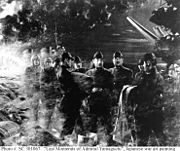
Last Moments of Admiral Yamaguchi by war artist Kita Renzo, 1942
Japanese official war artists were commissioned to create artwork in the context of a specific war.[1] The artists were creating sensō sakusen kirokuga ("war campaign documentary painting") for the government of Japan.[2] Official war artists have been appointed by governments for information or propaganda purposes and to record events on the battlefield;[3] but there are many other types of artists depicting the subject or events of war. Between 1937 and 1945, Japan’s military leaders commissioned official war artists to create images of the Second Sino-Japanese War and the Pacific War. Approximately 200 pictures depicting Japan’s military campaigns were created. These pictures were presented at large-scale exhibitions during the war years.[2]
Second Sino-Japanese War[]
The Japanese military supported artists during this conflict. For example, Tsuguharu Foujita was sent to China as an official war artist by the Imperial Japanese Naval Information office. In 1938, he traveled to the battlefield front in central China.[4]
- Tsuguharu Foujita, 1886–1968.[5]
Pacific War[]
Pearl Harbor Attack, December 7, 1941 by war artist Tsuguharu Foujita, 1942. Oil on canvas, 2.7 x 1.7 m.
The Landing in the Aleutians by Tomoharu Mikami (7–8 June 1942). Japanese Naval personnel in Alaska (June 7–8, 1942)
The Japanese government and military supported an extensive war art program involving hundreds of artists; however, little is known about it. In part, this is because the U.S. government confiscated the extant artwork. Many of the records have not been examined for scholarly review.[6]
- Tsuguharu Foujita.[7]
- Ryushi Kawabata, 1855–1966.[7]
- Ryohei Koiso, 1903–1988.[7]
- Shin Kurihara, 1894–1966.[7]
- Saburo Miyamoto, 1905–1974.[7]
- Kenichi Nakamura, 1895–1967.[7]
- Kita Renzo (1876–1949)
- Konosuke Tamura, 1903–1986.[7]
- Kenji Yoshioka, 1906–1990.[7]
See also[]
- War artists
- Military art
- War photography
Notes[]
- ↑ McCloskey, Barbara. (2005). Artists of World War II, pp. 111–126.
- ↑ 2.0 2.1 Tsuruya, Mayu. "Cultural Significance of an Invisible Emperor in Sensô Sakusen Kirokuga ('War Campaign Documentary Painting')." Association for Asian Studies (AAS), Annual Meeting (Boston, Massachusetts), March 22–25, 2007.
- ↑ National Archives (UK), "'The Art of War,' Learn About the Art."
- ↑ McCloskey, p. 117.
- ↑ Nussbaum, "Fujita Tsuguharu" in Japan Encyclopedia, p. 200; McCloskey, p. 117.
- ↑ McCloskey, p. 111.
- ↑ 7.0 7.1 7.2 7.3 7.4 7.5 7.6 7.7 Nara, Hiroshi. (2007). Inexorable Modernity: Japan's Grappling with Modernity in the Arts, p. 97 n47., p. 97, at Google Books
References[]
- McCloskey, Barbara. (2005). Artists of World War II. Westport: Greenwood Press. 10-ISBN 0313321531/13-ISBN 9780313321535; OCLC 475496457
- Nara, Hiroshi. (2007). Inexorable Modernity: Japan's Grappling with Modernity in the Arts.Lanham, Maryland: Lexington Books. 13-ISBN 9780739118412/10-ISBN 0739118412; 10-ISBN 0739118420/13-ISBN 9780739118429; OCLC 238825589
- Tsuruya, Mayu. (2005). Sensô Sakusen Kirokuga ("War Campaign Documentary Painting"): Japan's National Imagery of the 'Holy War', 1937–1945. Ph.D. dissertation, University of Pittsburgh.
The original article can be found at Japanese official war artists and the edit history here.